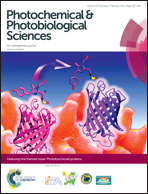Multi-component lanthanide hybrids based on zeolite A/L and zeolite A/L-polymers for tunable luminescence†
Abstract
Some multi-component hybrids based on zeolite L/A are prepared. Firstly, zeolite A/L is loaded with lanthanide complexes (Eu-DBM or Tb-AA (acetylacetone = AA, dibenzoylmethane = DBM)) into its channels. Secondly, 3-methacryloyloxypropyltrimethoxysilane (γ-MPS) is used to covalently graft onto the surface of functionalized zeolite A/L (Si-[ZA/L⊃Eu-DBM(Tb-AA)]). Thirdly, lanthanide ions (Eu3+/Tb3+) are coordinated to the functionalized zeolite A/L and ligands (phen(1,10-phenanthroline) or bipy (2,2′-bipyridyl)) are introduced by a ship-in-bottle method. The inside–outside double modifications of ZA/L with lanthanide complexes afford the final hybrids and these are characterized by means of XRD, FT-IR, UV-vis DRS, SEM and luminescence spectroscopy, some of which display white or near-white light emission. Furthermore, selected above-mentioned hybrids are incorporated into PEMA/PMMA (poly ethyl methylacryate/poly methyl methacrylate) hosts to prepare luminescent polymer films. These results provide abundant data that these hybrid materials can be expected to have potential application in various practical fields.


 Please wait while we load your content...
Please wait while we load your content...